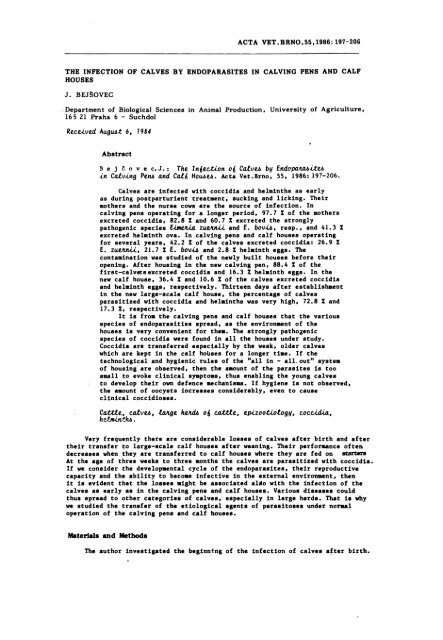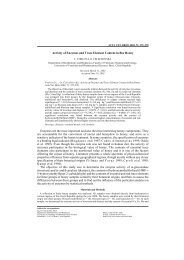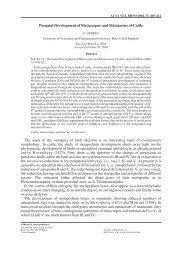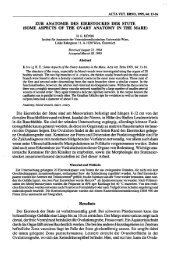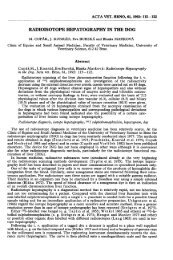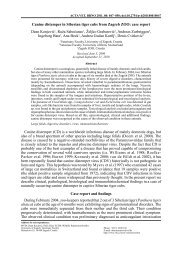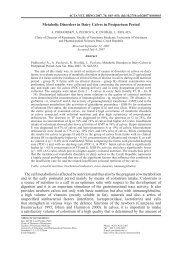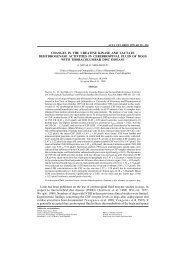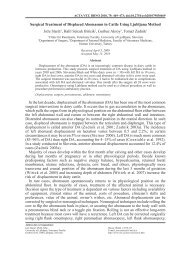Full text - Acta Veterinaria Brno
Full text - Acta Veterinaria Brno
Full text - Acta Veterinaria Brno
You also want an ePaper? Increase the reach of your titles
YUMPU automatically turns print PDFs into web optimized ePapers that Google loves.
ACTA VET.BRNO,55,1986: 197-206<br />
THE INFECTION OF CALVES BY ENDOPARASITES IN CALVING PENS AND CALF<br />
HOUSES<br />
J. BEJSOVEC<br />
. Department of Biological Sciences in Animal Production, University of Agriculture,<br />
165 21 Praha 6 - Suchdol<br />
Received AugU6t 6, 1984<br />
Abstract<br />
!I e j l: 0 v e c, J.: The III6el!.ti.01l 06 Ca.lvu by Elldopa.!lJUU:u<br />
ill Ca.lv~lIg Pen6 and Ca.l~ HOU6U. <strong>Acta</strong> Vet.<strong>Brno</strong>, 55, 1986: 197-206.<br />
Calves are infected with coccidia and helminths as early<br />
as during postparturient treataent, sucking and licking. Their<br />
mothers and the nurse cows are the source of infection. In<br />
calving pens operating for a longer period, 97.7 % of the mothers<br />
excreted coccidia, 82.8 % and 60.7 X excreted the strongly<br />
pathogenic species ~ Zu~ and E. bovi6, resp., and 41.3 %<br />
excreted hel.inth ova. In calving pens and calf houses operating<br />
for several years, 42.2 % of the calves excreted coccidia: 26.9 %<br />
E. zu~, 21.7 % E. bovi6 and 2.8 % helminth eggs. The<br />
contamination was studied of the newly built houses before their<br />
opening. After housing in the new calving pen, 88.4 % of the<br />
first-calversexcreted coccidia and 16.3 % hel.inth eggs. In the<br />
new calf house, 36.4 % and 10.6 % of the calves excreted coccidia<br />
and helminth egga, respectively. Thirteen days after establishment<br />
in the new large-scale calf house, the percentage· of calves<br />
parasitized with coccidia and hel.inths was very high, 72.8 % and<br />
17.3 %, respectively.<br />
It is fro. the calving pens and calf houses that the various<br />
specie. of endopara.itie. spread, as the environaent of the<br />
houses is very convenient for the.. The .trongly pathoaenic<br />
specie. of coccidia were found in all the hou.es under study.<br />
Coccidia are transferred especially by the weak, older calv ••<br />
which are kept in the calf hobses for a longer tiae. If the<br />
technological and hygienic rules of the "all in - all. out" system<br />
of housing are observed, then the amount of the parasite. is too<br />
small to evoke clinical symptoms, thus enabling the young calves<br />
to develop their own defence mechanis... If hygiene is not observed,<br />
the amount of oocysts increases considerably, even to cause<br />
clinical coccidioses.<br />
Very frequently there are considerable losses of calves after birth and after<br />
their transfer to large-.cale calf hou.ea after weaning. Their performance of tan<br />
decrea.e. when they are transferred to calf hou.e. where they are fed on ~<br />
At the age of three weeka to three months the calve. are parasitized with coccidia.<br />
If we consider the d.velopmental cycle of the endopara.ite., their r.productiv.<br />
capacity and the ability to becoae infective in the external environment, then<br />
it i. evident that the los.e •• ight be as.ociated al.o with the infection of the<br />
calve. a. early as in the calving pens and calf hou •••• Varioua diseaaea could<br />
thus .pread to other categories of calves, especially in large herd •• That is why<br />
we studied the transfer of the .tiological agents of paraBitoses under norma.l<br />
operation of the calving pens and calf houses.<br />
Materials and Methoda<br />
The author investigated the beginning of the infection of calve. a~ter birth.
198<br />
Table I<br />
Excretion of oocysts of the less pathogenic species of coccidia and of helminth eggs<br />
by calves in calving pens and calf houses<br />
Age of calves 1-2 3 - 4 5 - 7 8 - 10 11 - 20 21 - 30 31 - 40<br />
days<br />
EimeJL.ia 0.3 0.4 1.3 1.2 7.8 19.6 24.4<br />
alabamen6.i.6 0.5 0.1 0.9 0.5 4.3 18.1 14.1<br />
133 33 33 66 166 866 233<br />
EimeJL.ia 0.8 0.8 0.8 1.5 3.6 13.3<br />
aubWtnen6.i.6 0.4 0.7 0.2 0.3 1.8 11.8.<br />
100 33 33 33 133 66<br />
EimeJL.ia 0.3 1.7 0.8 2.0 2.6 8.9 20.0<br />
bulUdnonen6.i.6 0.1 0.9 0.7 0.6 1.6 9.5 9.6<br />
33 133 33 33 166 300 66<br />
f.imeJL.ia 5.0 6.7 6.1 13.3 16.9 31.1<br />
6ub6phllica 12.5 4.6 1.9 9.7 11.9 14.8<br />
2200 100 100 166 533 100<br />
f.imeJL.ia 0.3·<br />
wyom-ingen6.i.6 0.1<br />
33<br />
Capi.Uq.Jr.A.o. spp. 0.4 0.8 0.7 1.8 4.4<br />
0.1 0.3 0.2 1.4 1.4<br />
33 33 66 133 33<br />
Haemonchu6 0.4 0.4 2.2<br />
contoJttu.6 0.1 0.3 0.7<br />
33 66 33<br />
OUophago6tonum 0.8 0.3<br />
spp. 0.2 0.2<br />
33 66<br />
StMngyio.idu 0.4 1. 3.6<br />
pap.iUo6U6 0.1 0.5 2.7<br />
33 66 100<br />
T4icho6tMngyiU6 0.3 O. 2.2<br />
spp. 0.1 O. 0.7<br />
33 33 33<br />
T4ichu4i6 1.7 0.4 O. 3.6 6.6<br />
spp. 1.4 0.1 O. 3.5 2.9<br />
33 33 33 233 66<br />
Number of calves<br />
examined 316 240 237 248 270 112 45<br />
Numbers in table indicate: % of calves excreting coccidia oocysts and egg helminths.<br />
Average number of oocysts (eggs) in 1 gram of faeces.<br />
Maximum number of oocysts (eggs) in 1 gram of faeces.<br />
For better orientation in the table, the zero values were left out.<br />
In young calves, usually no fecal examinations are carried out because the excretion<br />
of coccidia oocysts begins 6 to 22 days after infection (the prepatent period is<br />
yet uncertain in some species). Helminth ova and larvae are excreted later still.<br />
Many authors observed the transit of parasites through the alimentary tract of<br />
specific hosts. Mac k 0 (1979. 1980) e.g. found that a conSiderable amount of<br />
infective helminth egga and larvae psss through the alimentary tract of specific<br />
hosts. B e j ! 0 vee (1983) observed a tran~it of coccidia oocysta in calve.<br />
in the prepatent period after birth. In the very young calves; food passes through
the alimentary tract relatively quickly. That is why the calves were examined<br />
copro1ogica1ly beginning fro. the age of 20 hours. The qualitative flotation<br />
method after Breza (1957) was used as it is very effective and the quantitative<br />
method after Bra z a and ~ v arc (1967). More time was devoted to the<br />
examinations than to common. routine diagnosio.<br />
In the new calving pen and new calf house recently put into operation. 43<br />
mothers and 66 calve. were examined. After introduction into the new large-scale<br />
calf hou.e. 81 calve. were examined. In calving pens and calf houses which had been<br />
in operation for a longer time. 600 mothers. 200 nurse cows snd 1 468 calves were<br />
examined.<br />
199<br />
Results<br />
Calves begin to excrete coccidia from the first day of their life. At the age of<br />
one day. EimtiLUt zue.ttnU. E. bovu, E. e.tUp4o.ida.U.6 and E. a1I:tbamell4u were<br />
found in 3.2 %. 1.6 %. 0.8 % and 0.8 % of the calves. respectively. At the age of<br />
two days. already 7.8 %. 6.7 %.0.5 % and 0.5 % of the calves were shedding<br />
E. zue.ttnU. E. bovu, E. e.tUp4o-ida.U.4 and E. bulUdnonell4u. respectively. At<br />
the age of two days. helminth
Table 2<br />
Flndinp of endoparaaites in animals after ftrst housing in new buUdinp<br />
Ii.<br />
Do<br />
t<br />
II<br />
-~<br />
N<br />
C><br />
C><br />
Coccidia<br />
Helminths<br />
",,_.In<br />
calvtna<br />
,<br />
DAn<br />
.~<br />
.~ .~ ~<br />
~<br />
~<br />
3<br />
E<br />
a 3 a 3 's<br />
~ ~ 1 ] J "ti.<br />
~ ~<br />
.~<br />
:~<br />
:><br />
a ::I<br />
.Q N '*' U .2!<br />
...<br />
..; -..; ..; ..; ..; ..; ..; ..;<br />
27.9 65.1 7.0 U.O 7.0 27.9 11.6<br />
.-. " 32 27 3 5 2 11<br />
SOO 166 100 66 33 66 66<br />
-<br />
..... 66 100 100 33 33 66 100<br />
..... 13966 6033 8366 7133 700 5U3 S633 7533<br />
Celv •• fn<br />
, 6.1 16.7 7.6 3.0 1.5 9.1 16.7<br />
cltf houle e 2 8 5 1 0,5 3 8<br />
Cllv.. kept for 13<br />
, 9.9<br />
--.-<br />
16.0 8.6 3.7 21.0 39.5 30.9<br />
cloy. In c.lf hou •• e U9 181 267 121 17 51 1_0 H8<br />
Numbers in table indicate:" of infected animals<br />
• average numbers of oocysts, eggs in 1 g<br />
of faeces<br />
max. maximum numbers of oocysts, eggs in<br />
1 g of faeces<br />
ci. ci.<br />
Do Do<br />
~<br />
ci. II II<br />
Do<br />
II<br />
~~<br />
.~<br />
~~ .~<br />
~<br />
~~<br />
Ii l'~ ~~<br />
oj a a<br />
201<br />
Fig.<br />
Excretion of endoparssites by mothers.<br />
Fig. 3.<br />
Excretion of endoparasites by nurse<br />
cows.<br />
White columns indicate the % of cows<br />
excreting the individual coccidia<br />
(above) and helminth (below) species<br />
Lower black columns indicate the<br />
total paraSitization of cows with<br />
coccidia and helminths. The numbers<br />
below indicate the % of parasitized<br />
animals. Values were obtained by<br />
examinations of SOO cows.<br />
TILic.hol.tllongy.lu.4 spp. were found. From the second to the ninth days of age the<br />
number of calves excreting coccidia oocysts increased. This increase was remarkable<br />
,with calves shedding the strongly pathogenic species E. zueII.ILU and E. bov.i.l.<br />
Further increase of the extensity and intensity of coccidial infections appeared<br />
after the age of 20 days. The increasing infection rates from the first day of life<br />
can be seen from the curves in Fig. 1 and the upper lines of Tab. 1.<br />
After the prepatent period, the extensity of the infection with E. zueII.ILU and<br />
E. e1Li.p6o-id0.ti6 . expressively increased from the 3rd day of life. The extent of the<br />
infection with other coccidia species after the prepatent period did not increase<br />
significantly.<br />
In calving pens and calf houses used for a longer time, 42.2 % of the calves<br />
shed coccidia oocysts: 26.9 % shed E. zuell.lLU, 21. 7 % E. bov.i.l, 7.6 %<br />
E. ~ub~phruc.a, 6.S % E. elliFMo.uto.LiJ., 4.1 % E. ab.baJlle~.i.I, 2.6 %<br />
E. bulUdnone~.i.I, 1.9 % E. c.yUndlLic.a, 1.3 % E. ClUbUJUIe~.i.I , and 0.1 %<br />
E. wyom,£nge~.i.I. Only 2.8 % of the calves shed helminth eggs: 0.9 % calves shed<br />
TILic.~ spp., 0.8 % StIlongylo-idu papdlo~~, 0.7 % CapdlalLia spp., 0.3 %<br />
HaeJltOnc.~ c.onto1Ltu6, 0.2 % T lLic.ho4t1longy.lu.4 spp., and 0.2 % OuophagO~tOIllWll<br />
spp.<br />
Since the findings of parasites in the youngest calves were very unusual, their<br />
mothers were examined as well. In calving pens used for a longer time, only 2.3 %<br />
of the mothers did not excrete coccidia; 82.8 % of the mothers excreted E. zueII.ILU<br />
oocysts, 60.6 % E. bov.i.l, 32.8 % E. c.yUndlLic.a, 32.1 % E. 4ub4phruc.a, 25.3 %<br />
E. bulUdnone~.i.I, 22,6 % E. elliFMo~, 13.6 % E. ab.bClllt~.i.I, 10.2 %, E.ClUbUJUI~.i.I,<br />
5.3 %, E. wyom,£nge~.i.I, and 2.5 % IM4PO/w' spp. Helminth eggs were excreted by 41.3 % of<br />
the mothers: 10.5 % were TILic.~ spp., ~.6 % CapdlalLia spp., 6.3 % Chabell.Ua<br />
ov-ina, 4,5 % HaeJltOnc.~ c.onto1Ltu6, 3.1 % StIlongylo-idu papdlo~~, 3.0 % .<br />
Ouophago4tolllWll spp., 1.8 % TILic.ho~tIlongy.lu.4 spp., 1.1 % 8uno~tolllWll phlebotolllWll,<br />
0.6 % CooPf,lLia spp., 0.2 % 04tell.tag-ia spp., and 0.2 " Mon-iez-ia spp.<br />
The infection was heavy also in the nurse cows: 76.5 % excreted E. zueII.ILU<br />
oocysts, 49.0 % E. bov.i.l, 40.5 % E. c.yUndlLic.a, 39.0 % E.elliFMo-id0.ti6, 14.0 %<br />
E. ClUbUJUIe~.i.I, 11.5 % E. ~ub~phruc.a, 9.5 % E. bulUdnone~,u,., and 6.0 % E.<br />
ab.baJllew. In total, 94. 5 % of the nurse cows excreted coccidia oocysts.<br />
Enterohelminth eggs were excreted by 29.5 % of the nurse cows: 10.5 % were<br />
CapdlalLia spp., 9.5 % TILic.~ spp., 5.5 % Chabell.Ua ov-ina, 4.5 % HaVllonc.~<br />
conto1Ltu6, 2.5 % StIl.,ngylo,(,du pa(JUl04~, and 1.5 %. TJLicho~tIlong'l.lu.4 spp.
202<br />
The new buildings were compared with calving pens and calf houses used for<br />
a longer time. After introduction into the new calving pen, 88.4 % and 16.3 % of<br />
the first-calvers excreted coccidia oocysts and helminth eggs, respectively. In the<br />
new calf house, 36.4 % and 10.6 % of the calves excreted coccidia and he!.minths,<br />
respectively. Thirteen day·. after introduction into the new large-scale calf house,<br />
7Z.8 % and 17.3 % of the calves were parasitized with coccidia and helminths,<br />
respectively. Tab 2. shows the species and number of parasites. The species<br />
composition of the parasites shows the whole spectrum of endoparasites tran.ferred<br />
as early as during the introduction of the animals into the new buildings. The<br />
strongly pathogenic coccidia species were brought into all new buildings.<br />
Observations of the animals under study showed that the parasitisms were<br />
transferred during the time when the calves sucked under their mothers or nurse<br />
cows ,when they licked and sucked each other, and the walls, pens, stall . partitions,<br />
pipelines, central heating body, and other objects. The calves housed in the boxes<br />
together with mothers were exposed to coccidia and helminths most heavily. Calves<br />
housed individually in pens and in separate stanchion pens were found to excrete<br />
oocysts sporadically.<br />
Also in the calving pens and calf houses used for a longer time, the majority<br />
of calves was not exposed to mass infestations and ingested only smaller amounts of<br />
parasites. The numbers given in the last line of Tab. 2 indicate that a great<br />
propagation of coccidia occurs in calves transferred into the newly built large-scale<br />
calf house. Calves infected in the calving pens and calf houses could be the source<br />
of heavy contamination of large-scale calf houses.<br />
Discussion<br />
As early as in 1964, when there were only a few large-scale calf houses in the<br />
Czechoslovak Socialist Republic, C h r 0 u s t (1964) warned that c6ccidiosis<br />
usually begins in one or a few calves. Light infections are not noticed and the<br />
calves become dangerous sources of coccidia. Ham m 0 n d (1964) drew attention<br />
to the fact that coccidiosis in cattle can be gradually caused by a single oocyst. The<br />
reproductive potential of EUflvUo. zueJUt.U is 1 : 14000 and of E. bov,u it is<br />
1 : 250 000 (F u c h s 1983). From the epizootiological point of view, smaller<br />
amounts of parasites should also be taken into account because they are able to<br />
reproduce rapidly especially in large-scale houses.<br />
5 van b a e v (1967) found coccidia oocysts on the udders of cows. Z a j I<br />
e e k et al. (1977) examined heifers and pregnant cows from 25 farms of the<br />
supply region of the calf house and on the basis of oocyst findings they reported<br />
that: "From the etiological point of view it is necessary to take into account the<br />
transfer of coccidia by calves from their maternal houses." Our findings in calves<br />
soon after birth fully confirm these opinions. Z a j lee k (1982) draws attention<br />
to the fact that at the present time the problem of clinical diseases caused by<br />
coccidiosis is coming to the fore in large-scale calf houses; in some districts in<br />
Bohemia, as many as 0.14 - 15.12 % of calves from the housing suffered from<br />
coccidiosis, 5 - 100 % of which died. The species E. zUeJln-U and E. bov,u were<br />
found to predominate in large-scale calf houses of the industrial type. Both species,<br />
found most frequently by Z a j lee k (1982) in the large-scale calf houses, were<br />
the most frequently found in calving pens and calf houses in the present study.<br />
E. bov,u oocysts sporUlate 2 - 3 days, those of E. zueJUt.U 3 - 4 days. In the<br />
modern large-scale buildings they become infective very quickly.<br />
P a v I a s e k (1982) examined 380 dairy cows on 11 farms from which the<br />
calves were transferred into a new central calf house, and he found coccidia in all<br />
these farms. In the newly opened large-scale calf house, the calves of the first<br />
housin g shed coccidia oocysts in the third week after transfer, calves of the 4th<br />
housing already in the first week. It was found that the longer the operation of<br />
the calf house, the shorter the period of a 100 % infection of the calves. 5 t e i' n<br />
b a c h (1982) diagnosed clinical coccidiosis in new calf houses 4 months after the<br />
houses where calves were fed on starters were fully occupied; he considered the<br />
source. of coccidiosis to be the region from which the calves wert) transferred.<br />
5 van b a e v (1967) observed first coccidia oocysts in a 10-day-old calf.<br />
Pro k 0 pic and P a v I a s e k (1977) found sporadic EimvUo. bov,u oocysts<br />
in a 12-day-old calf. Coccidia oocysts of the genus C1t!fpto4poucLiwn, not found in
Czechoslovakia until 1980, were excreted much earlier than coccidia oocysts of the<br />
genus EimVt.i4 (P a v I , s e k 1981). L u k e ii 0 v, et al. (1984),<br />
P a v I , s e k et al. (19B3) found CJr.I(pt:OllpoltULiwn sp. oocysts In calves of<br />
only 3 days of age; at the farm under study, ail the 6 to 14-day-old calves were<br />
excreting CJr.yptollpoltULiwn sp. oocysts. P a vi' s e k et al. (1983) studied<br />
the effect of different housing of the calves after birth on the occurrence of<br />
CJr.yptilllpoltULiwn sp. They found these coccidia in all the housing types in all the<br />
calve" but no significant effect of the system of housing on the occurrence of<br />
CJr.yptollpofLicLi.ulll infections was proved.<br />
S tel n et al. (1983) found 5 mUlion CJr.yptOllPOItULiwn sp. oocysts in 1 g<br />
of calf faeces as early as on the first day of the patent period. In the naturally<br />
infected calves they found as many as 74 million oocysts In 1 ml of faeces.<br />
F I s c her (1984) reported that: n ... it is true that coccidia of the genus<br />
CJr.yptilllpofLicLi.ulll are very frequent in calves, especially from the 5th tUl 30th day<br />
of life, but are not expressively manifested In large-scale houses because most of<br />
the infections die out with the increasing age of the calves. n Men ii i k et al.<br />
(1984) drew attention to the fact that the significance of cryptosporidia as primary<br />
pathogens has not yet been conclusively explained, n... It seems that they could be<br />
a facultative pathogen because they firmly adhere to the epithelial cells of the<br />
intestinal mucosa ••• and damage the microvilli.·<br />
The endogenous stages of coccidia of the genus EimVt.i4 (often found in the<br />
present material) develop mostly in the superficial layer of the intestinal mucOSa.<br />
Schizonts and sexual stages of E. zuVUIU parasitize in the epithelial cells of the<br />
small and large intestines and the caecum and they are, on average, 11 - 14 11m<br />
large (D a vis and Bow man 1957). E. boviA forms relatively large<br />
schizonts - on average 300 - 400 11m - in the endothelial cells of the vUli of the<br />
small Intestine. The second generation of schizonts is localized in the caecum and<br />
large intestine (H a m m 0 n d 1964). Endogenous stages of E. bov.i6 and E.<br />
aubWUlellll.i6 in the intelltines penetrate into the propria mucosae (G r a a f n e r<br />
and G r a u b man n 1979). In some Ei.mvWl species parasitizing in cattie, "<br />
the endogenous development Is not yet known. Coccidia of the genus EimVt.i4 often<br />
considerably damage the intestinal mucosa and thus allow the various microorganisms<br />
to penetrate.<br />
Men Ii i k et al. (1984), as well as other authors, report that the diseases<br />
occuring In the course of intensive calf rearing are, as a rule, due t::. the co-action<br />
of many microorganisms. From the present results it is evident that calves are<br />
parasitized as early as in the calving pens and calf houses.<br />
Calves In which the parasites were found, frequently licked the surrounding<br />
objects and other calves. Various authors (e.g. H I n t n a u s 1978) drew<br />
attention to the fact that mutual licking of calves is a mass phenomenon in large-scale<br />
herds due to the fact that calves were taken away from their mothers very early and<br />
given artificial feed. V l! f i ii and N a v r , til (198Z) observed that the,<br />
calves start licking each other from the first day of life, from the third day they<br />
begin to suck each others ears, umbilical stump and genitalia. This mutual licking<br />
and sucking was found to become more frequent in calves placed into a common pen<br />
after birth. In calves housed in byres with stanchions and in groups, as well as in<br />
calves housed in individual pens, the frequency of licking increased with age. Calves<br />
suffering from diarrhea licked the walls very Intensively and for a very long time<br />
(because of thirst due to dehydration). Nil 1 0 (1970) noted that oocysts in the<br />
faeces sticking to the hair coat of the cattle can sporulate due to<br />
the effect of body temperature and infect the animal licking its body surface. In the<br />
present material, from the second day of age, the number of calves excreting oocysts<br />
of E. zuVUIU and E. Iiov.i6 (see Fig. 1), very widely spread in large-scale herds,<br />
increased. It Is evident that frequent licking of various'surfaces as well as licking<br />
each other brings the infective agents into the calves' alimentary tract.<br />
Observations of the calves examined in the present study showed that the<br />
parasites are transferred already due to insufficient cleaning of the oral cavity during<br />
post-parturition treatment and due to insufficient treatment, of the calves malnlY'5durlng<br />
night parturitions. on Sundays, and when the attendants are beinll relieved. Dirty<br />
hair coat of the cows In litter-free calving pens affects the hygiene of parturition<br />
and may contaminate the environment. The work of the attendants greatly influences<br />
the transfer of parasites in calving pens and calf houses. especially when technological<br />
Z03
204<br />
and hygienic rules are neit observed. In the present material. sometimes the<br />
endoparasite species of the mother did not agree with that of her own calf. but<br />
among the calv.es and other mothers in the same calving pen they did. From<br />
conforming findings of various farms it is ev.ident that large-scale buildings are<br />
contaminated with endoparasites already at the beginning of operation and that the<br />
source of infection are not only the true mothers. The present results showed that<br />
the transfer of coccidia into the alimentary tract of the animals cannot be prevented<br />
at the present time under operational conditions~ Clinical disorders are most<br />
frequently produced by a larger number of parasities that could be effectively<br />
limited when establishing "all in - all out" systems of housing.<br />
Measures aimed at control of endoparasite transfer are similar to those aimed<br />
at prevention of bacterial and viral contamination of premises. It is a must to observe<br />
the hygiene of udder. cleanness of the vessels from which· the calves drink. to keep<br />
the floor clean and to change the litter in the boxes of the calves very regularly.<br />
Faeces should be removed especially from the surfaces licked by the calves. •<br />
J e h I i f k a (1966) noticed a sucking reflex which lasted for 30 minutes after<br />
the calf drank mUIt. He reccomends tliat the calves be fixed for about half an hour<br />
after drinking milk until the sucking reflex disappears. Pol ik (1980) and other<br />
authors recommended the "all in - all out" system of housing f .... calf houses as well.<br />
Men II i k et aI. (1983) recommended calv.ing pens with this operation in isolated<br />
sections. They recommend that the calf house be divided into a larger number of<br />
separate sections. or at least into two parts. with alternating operation in order that<br />
the free part could be disinfected. and to house the calves intoindiv.idual box.es.<br />
K r e j f i et al. (1984) and other authors propose similar measures. The measures<br />
proposed are very convenient also for reducing the transfer of endoparasites in<br />
calving pens and calf houses. Coccidia oocysts and helminth eggs are very resistant<br />
to various disinfectants. That is why regular and tborcugh mechanical cleaning<br />
remov.ing most of the parasites is so important.<br />
H 0 j 0 v e c et al. (1973) drew attention to the fact that the preventive<br />
measures should be aimed. in the first place. at increasing the specific resistance<br />
of the calv.es even before transport into large-scale calf houses. Repeated examinations<br />
showed that the majority of mothers and nurse cows are virtually permanently<br />
parasitized with coccidia (frequently with several species). The nearly permanent<br />
presence of endoparasites in the organism enables to obtain and maintain antiparaaitary<br />
immunity of the mothers and to form conditions for colostral immunity of<br />
the calves. Small doses of parasites create conditions for the development of defence<br />
mechanisms ..·early as in the very young calves.<br />
In the present material from various calving pens and calf houses. coccidia of<br />
the genus EimeJlia were found in very low intensities. helminths only sporadically.<br />
It is improbable that the endoparasites mentioned would be of greater importance in<br />
diarrheal disorders of newborn calves. More important is the transfer of coccidia<br />
from calving pens and calf houses into large-scale calf houses.<br />
Inftlrodni teat endoparality v porodn4ch a profylaktorilch<br />
Telata jllOu infikovtna kokcidiemi a helminty jii pfi poroditim olletfovini. sini a<br />
olizovini. Zdrojem nikazy jsou matky a kojne krtvy. V dele poulivanych porodnich<br />
vylufovalo 97.7 , matek kokcidie. sUni! patogenni druhy EimeJlia zueJ/II.U 82.8'.<br />
E. bov.u 60.7 ,. helminty vylufovalo 41.3 , matek. V porodnich a profylaktoriich<br />
ulivanych vice let vylufovalo 42.2 , telat kokcidie: 26.9 9; E. zueJ/ll.U. 21.7 ,<br />
E. bov.u a 2.8 , helminty. Byla sledovina kontaminace novi! vybudovanych objektd<br />
pH uvidi!ni do provozu: Po zavedeni do otevirane porodny vylufovalo 88.4 , prvotelek<br />
kokcidie a 16.3 , helminty. V novem profylaktoriu vylufovalo 36.4 , telat<br />
kokcidie a 10.6 , helminty. Za 13 dnd po naskladni!ni do noveho velkokapacitnlho<br />
teletnlku bylo jil 72.8 , telat parazitovtno kokcidiemi a 17.3 9; helminty.<br />
Jil z poroden a profylaktoril se Iliff druhy endoparazitd (jsou uvedeny ve vysledclch).<br />
kterj'm ekologicky vyhovuje stijove prostfedi. SiIni! patogenni druhy<br />
kokcidii byly shodni! zjilltov.tny v.e vllech sledovanych objektech. Kokcidie pfentiieji<br />
zejmena slabi. starlli telata. kteri byvaji ponechtvtna dele v profylaktoriich. Pfi dodrlovtni<br />
technologicke a hygienicke kbni! turnusoveho zistavu je mnozstvi parazltirnich<br />
agens pfilill male k vyvolini klinickych pfiznakd. ale umolnuje rozvoj obran-
205<br />
nych mechanismll velmi mladych telat. Pfi nedodriovo!.nf hygieny se znacni! zvy§uje<br />
mnoistvf oocyst. ktere mohou pllsobit klinicke kokcidiozy.<br />
TenJiTa HHtHIlHPOBilHbI JCOJCIlH.!lHaMH H re.nbMHHTaMH YlKe B nepHO.!l<br />
nOCnepO.!lOrO y~O.!la. COCaHHJI H 06nHSblBaHHJI. HCTOQHHJCOM SapalKeHHJI<br />
JlBnJl~TCJI MaTJCH H JCOPOBbI-JCOpMHnHllbi. B.!lnHTenbHOe BpeMJI HcnonbsyeMbix<br />
p0.!lHnbHblX nOMe.eHHJlX 97,7 , MaTOJC BbI.!lenJlnHJCoJCIlH.!lHH, 82,8 , HHTeHCHBHO<br />
naToreHHble BH.!lbl EUneJLia zuvmU. 60,7' - E. bov.t4, renbMHHTbI BbI.!lenJinH<br />
41,3 , MaTOJC. B HaXO.!lJl.HXCJI B 3JCcnnyaTallHH B TeQeHHe HeCJConbJCHX neT<br />
pO.!lHnbHblX nOMe.eHHJlX H npotHnaJCTopHJlX 42,2 , TenJiT BbI.!lenJinH JCOJCIlH.!lHH:<br />
26,9 , - E. zuvmU. 21.7' E. bov-i.6 H 2,8 , - renbMHHTOB. npoBO.!lHnHCb<br />
HCCne.!lOBaHHJI JCOHTaMHHallHH BBO.!lHMblX B 3JCcnnyaTallH~ HOBbiX 06~eJCTOB:<br />
B ynoMJIHYTblX 06~eJCTax 88,4 , HOBOTenbHblX JCOPOB BbI.!lenJinH JCOJCIlH.!lHH H<br />
16,3 , - renbMHHTbI. B HOBOM npotHnaJCTopHH BbI.!lenJinH 36,4 , TenJiT JCOJCIlH.!lHH<br />
H 10,6 , - renbMHHTbI. qepes 13 CYTOJC nocne SaHJlTHa HOBoro JCpynHoro<br />
TenJlTHHJCa YlKe 72.8 , TenJiT 6b1nH sapalKeHbI JCOJCIlH.!lHJlMH H 17,3 , - renMHHTaMH.<br />
YlKe HS po.!lHnbHblx nOMe.eHHA H npotHnaJCTopHeB pacnpOCTpaHJlmTeJl BH.!lbl<br />
eH.!lOnapaSHToB (OHH npHBe.!leHbI B pesynbTaTax), .!lnJl JCOTOpblX 3JConOrHQeCJCH<br />
npHeMneMa cToAnOBaJi cpe.!la. naToreHHble BH.!lbl JCOJCIlH.!lHA 6b1nH aHanOrHQHO<br />
BblJlBneHbI no Bcex HCCne.!lyeMbix 06~eJCTax. nepe.!laTQHJCaMH JCOJCIlH.!lHeB JlBnJl~TCJI<br />
oc06eHHO cna6b1e TenJiTa cTapmero BospacTa, HaXO.!lJl.HeCJI .!lnHTenbHoe BpeMJI<br />
B npotHnaJCTOPHJJ • npH c06n~.!leHHH TexHOnOrHQecJCoA H caHHTapHo-rHrHeHH<br />
QecJCoA .!lHCUHnnHHbI QHCneHHOCTb napasHTapHbIX aJCTHBHblX taJCTopoB HeSHaQHTenb<br />
Ha .!lnJl Toro, QT06b1 BbiSBaTb npOJIBneHHJI JCnHHHQeCJCHX npHsHaJCoB, HO OHa<br />
cnoc06cTByeT paSBHTH~ sa.HTHbiX MexaBHSMOB TenRT paBBero BospaCTa. npH<br />
Hec06n~.!leBHH rHrHeHbI SBaQHTenbHO YBenHQHBaeTCR QHCnO OOIlHCTOB, JCOTopble<br />
MoryT BbiSBaTb JCnHHHQeCJCHA JCOJCUH.!lHOS.<br />
References<br />
BEJ~OVEC. J.: Discharge of oocysts coccidia by young calves in the prepatent period.<br />
J. Protozool.. 30. 1983: 29 A.<br />
BREZA. H.: Some practical knowledge and suggestions to the helminthcoprologic<br />
diagnostic. Helminthologia. 1.1957: 57-63. (in Slovak).<br />
BREZA. H. - ~VARC. R.: Eine einfache Methode zur Bestimmung der Einzahl gastrointestinaler<br />
Strongylaten in den Faeces d.er Wiederk4uer. Studia Helmintol. Koliice. 1967.<br />
CHROUST. K.: Kokcidioza u telat. Coccidiosis in calves. <strong>Acta</strong> univ. agric. <strong>Brno</strong>. B 12 •.<br />
1964: 209-223.<br />
DAVIS. L.R. - BOWMAN. C.W.: The endogenous development of Eimeria zuernii. a pathogenic<br />
coccidium of cattle. Am. J. Vet. Res •• 18. 1957: 569-574.<br />
HOJOVEC. J. - KRAITR. J. - MARKOVI~. P. - PYTLOUN. J. - ~RAMEK. J. - MEN~IK. J. -<br />
HAVELIK. J. - VASA. V. - VRBI~ANOvA. H. - ANTAL. J. - BLAHO. R. - HUBINSKt. J. -<br />
MEDVECKt. J. - KOUBEK. J.: Odchov telat ve velkokapacitnich teletnicich. Metodiky<br />
~SAZ OYTI Praha 1973. p. 31.<br />
FISCHER. 0.: Ekonomicky vyznam kokcidii rodu Cryptosporidium pro odchov telat. Vet.<br />
med. Praha. 29. 1984: 419-424.<br />
FUCHS. C.: 1l'.J!. Bedeutmg der Kokzidiose fur die KBlber- und ·Jul)grinderaufzucht sowie<br />
Massnamen zu ihrer Verhutung (Stall/Weide). Tierzucht. 37.19C3. 441-443.<br />
CRXFNER. c. - CRAUBMAN. H.D.: Betrachtungen zur Pathogenitat von Eiaeria-Arten am<br />
Beispiel der Rinderkokzidiose. Angew. Parasit •• 20.1979: 202-209.<br />
HAMMOND. D.H.: Coccidiosis of cattle; some unsolved problems. 30th Fac. Honor. Lech ••<br />
Utah State Univ •• Logan. Utah. 1964. p. 36.<br />
HINTNAUS. J.: Nove aspekty v etiologii sani respektive samasani mleka u dospelych<br />
pleaenic skotu. Referat na 5. etologicke konferenci Nitra 25.4.1978.<br />
JEHLI~KA. L.: Poznatky z etologie telat ve velkokapacitnich teletnicich. Otazky<br />
etologie hospodafskych zvifat ve velkovyrobnich podainkach. Praha. OVTI. 25. 1966:<br />
50-60.<br />
KREJ~r. J. - KUNC. D. - HRABE. J. - ~rp. J.: Prevence ztrat telat v syste.u otevieneho<br />
obratu stada skotu. Veterinahtvi. 34. 19114: 56-59.<br />
LUKE~OVA. D. - NEVOLE. J. - DANr~KOvA. H. - ~ALAMOUNOvA. Z.: Koznosti laboratorni<br />
diagnostiky kryptosporidiozni invaze u telat. Veterinifstvi. 34. 1984: 536-538.
206<br />
MACKO. J.K.: On helminth propagation by transit of invasive elements through<br />
definitive and intermediate hosts. Helminthologia Bratislava. 16. 1979: 127-140.<br />
MACKO. J.K.: On the grounds of transit of helminth invasive stages through the<br />
digestive tract of hosts with reference to the definitive hosts (s.I.).<br />
Helminthologia. Bratislava. 17.1980: 49-55.<br />
KEN~tK. J. - P~IKAL. I. - MADR. V. - ~TEpANEK. J. - PO~VAROvA. M. - TOMAN. M. -<br />
FRANZ. J. - VALO~KOvA. P. - PECKA. F. - JURMANOvA. K. - SALAJKA. F. - VALt~EK. L.<br />
. ~MtD. B. - KRECHLER. P. - KOHOUT. V. - KURIAL. J.: Model komplexni prevence ztrat<br />
telat na velkokapacitnich farmach ve slozitych epizootologickych podminkach. .<br />
Project Report. Veterinary Research Institute. <strong>Brno</strong>. 1983. p. 39.<br />
KEN~tK. J. ~ POSPt~IL. Z. - ~T!PANEK. J. - JuRAK. E. - MADR. V.: Soucasna epizootologicka<br />
situace v intenzivnich chovech skotu v souvislosti s nemocnosti a mortalitou<br />
telat v pr~behu jejich odchovu. Vet. Med. Praha. 29. 1984: 47-64.<br />
NILLO. L.: Bovine coccidiosis in Canada. Can. Vet. J •• 4.1970: 539-548.<br />
PAvLASEK. I.: First record of Cryptosporidium sp. in calves in Czechoslovakia. Folia<br />
par •• Praha. 28. 1981: 187-189.<br />
PAVLAsEK. I.: Dynamika vyskytu kokcidii u ctyf zastav~ telat ve velkokapacitnim teletniku<br />
Stara Hlina. Vet. Red •• Praha. 27.1982: 199-208.<br />
PAvLASEK. I. - ZIKMUND. B. - KLtMA. F.: Vliv r~zneho zp~sobu ustajeni telat po narozeni<br />
na vyskyt Cryptosporidium sp. Vet. Red •• Praha. 28.1983: 31-36.<br />
poLAK. L.: Soucasna situace v odchovu telat ve velkokapacitnich teletnicich v podminkach<br />
~SR. Sbornik Problemy odchovu telat ve velkokapacitnich teletnicich.V~Z Praha.<br />
1980: 4-14.<br />
PROKOPI~. J. - PAvLASEK. I.: Endoparaziti telat ve velkochovech. Vet. Red. Praha. 22.<br />
1977: 505-512.<br />
STEIN. E. - BOCH. J. - HEINE. J. - HENKEL. G.: Der Verlauf naturlicher Cryptosporidium<br />
-Infektionen iil vier Rindzuchtbetrieben. Berlo MUnch. TierarztI. Wschr.. 96. 1983:<br />
222-225.<br />
STEINBACH. J.: Kokcidioza a ostatni onemocneni telat. Informacni zpravy pro veterinarni<br />
a zemedelskou praxi SPOFA 1. 1982: 26-31.<br />
SVANBAEV. S.K.: Kokcidii svinej i krupnogo rogatogo skota v Kazachstane. An. Kaz.<br />
SSR. Trudy Inst. zool.. 28. 1967: 93-128.<br />
v!lt~. J. - NAVRATIL. J.: Chovani telat v obdobi po porodu v zavislosti na zp~sobu<br />
ustajeni. Sbornik Vys. ikolyzemedelske v Praze. B. 37.1982: 109-124.<br />
ZAJt~EK. D. - BISCHOFOvA. N. - ~ANDA. V. - FOJTtK. V.: Vyskyt kokcldii u telat ve velkochovu.<br />
Veterinafstvi. 27.1977: 507-508.<br />
ZAJt~EK. D.: Epizootologie kokcidiozy telat. Informacni zpravy pro veterinarni a<br />
zemedelskou praxi SPOFA. 1. 1982: 7-12.


